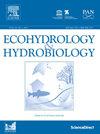浮游滤食者在半封闭泻湖(波罗的海南部)水中金属分布中的作用
IF 2.2
4区 环境科学与生态学
Q2 ECOLOGY
引用次数: 0
摘要
几十年来,特别是 20 世纪下半叶,人类活动在水体沉积物中沉积了大量金属。重要的是要确定决定其来源、路径、分布和季节动态的过程。我们在波罗的海南部第二大泻湖维斯瓦泻湖进行了这方面的研究。研究发现,风对浅水泻湖中金属浓度的大小和变化有很大影响。风决定了来自陆地的元素供应(主要是锰、锌、铀、钴)和来自污染较严重地区的元素在波罗的海咸水中的分布(钴、钒)。影响河口金属循环的另一个过程是絮凝。它促使铅、铝、铁、锰、镉和铍垂直迁移到沉积物表面。据观察,这些金属的浓度发生了变化,这主要是由于它们从陆地和沉积物中重新移动所致。因此,它们可能被纳入食物网,特别是铅、铀、钴、铍、锌、硒、铬、锶、钙、铝、铁、镍和镁。细胞中积累的金属数量和类型因浮游植物种类和细胞大小而异。蓝藻发挥了关键作用。未被消耗的降解有机物成为水中溶解铅、镍和锰的来源。本文章由计算机程序翻译,如有差异,请以英文原文为准。
The role of planktonic filtrators in the distribution of metals in the water of semi-closed lagoon (southern Baltic)
For decades of human activity, particularly in the second half of the 20th century a large load of metals has been deposited in sediments of water bodies. It is important to identify processes determining their origin, pathways, distribution, and seasonal dynamics. This was studied in the Vistula Lagoon, second largest lagoon of the southern Baltic. A significant effect of wind on the magnitude and variability of concentrations of metals in the shallow lagoon was observed. It determined the supply of the elements from land (mainly Mn, Zn, U, Co) and distribution within salty Baltic waters (Co, V) from more polluted areas. Another process affecting circulation of metals in estuaries was flocculation. It contributed to vertical transport of Pb, Al, Fe, Mn, Cd, and Be to the sediment surface. Changes in their concentrations were observed, largely due to their remobilisation from land and sediments. It may consequently allow their inclusion into the food-web, particularly: Pb, U, Co, Be, Zn, Se, Cr, Sr, Ca, Al, Fe, Ni and Mg. The amount and type of accumulated metals in the cells were different for each phytoplankton group and cell size. The critical role was played by cyanobacteria algae Oscillatoriales. Not consumed degrading organic matter becomes a source of dissolved Pb, Ni and Mn in water.
求助全文
通过发布文献求助,成功后即可免费获取论文全文。
去求助
来源期刊

Ecohydrology & Hydrobiology
Agricultural and Biological Sciences-Aquatic Science
CiteScore
5.40
自引率
3.80%
发文量
51
期刊介绍:
Ecohydrology & Hydrobiology is an international journal that aims to advance ecohydrology as the study of the interplay between ecological and hydrological processes from molecular to river basin scales, and to promote its implementation as an integrative management tool to harmonize societal needs with biosphere potential.
 求助内容:
求助内容: 应助结果提醒方式:
应助结果提醒方式:


